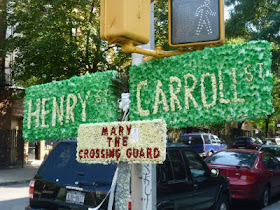
What hope is there for New York's more modest restaurants and bars when a chi-chi institution like Café des Artistes can't hack it?
The New York Times reported the grim news today that the old-style, Upper West Side slice of elegance decided during its August vacation never to reopen. Reasons given were "steady losses and a union lawsuit" and "tough competition from illustrious restaurants in the neighborhood, including Picholine on West 64th Street, Jean Georges at the Trump International Hotel and Daniel Boulud’s Bar Boulud on Broadway." “It’s a very sad day for us,” said Jenifer Lang, whose husband, George Lang, has owned the restaurant since 1975. “It’s a death in the family.”
One of the most romantic dining spots in the city, it was perhaps best known for its host, George Lang, who bought it in 1975, and the famous murals of dancing nymphs. It always stuck by its guns, serving the same dishes the restaurant had done well by in the past.
It does not appear that the Lang family had much of a choice:
Mrs. Lang, 58, said that the restaurant’s business had been hurt by the economic crash but that its problems ran deeper. Café des Artistes was unionized, and she said the restaurant paid about $250,000 a year to cover its employees’ health and pension benefits, an amount she said the restaurant struggled to cover. Mrs. Lang also said the couple, whose home is half a block from the restaurant, put in $2 million of their own money to keep it running over the last 10 years.
“It makes it difficult to run a restaurant most of the time,” Mrs. Lang said of the union benefits. “When the economy is down, it makes it impossible.”
The final straw, Mrs. Lang said, was a lawsuit recently filed against the restaurant by the union demanding past benefit assessments.
Bill Granfield, president of Local 100 of Unite Here, the union representing the cafe’s 50-odd employees, said the restaurant had fallen behind on its payments for medical insurance and welfare funds, forcing the union to demand payment in court. He also said workers in 2003 took a pay cut and agreed to switch to a cheaper medical plan to ease the restaurant’s financial pressures.
“And here we are six years later, facing what might’ve been inevitable,” said Mr. Granfield. “We think Mr. Lang is a great figure in the restaurant industry, a great person, and it’s a great restaurant. But it feels like time passed it by a while ago.”
There has been a restaurant in the space since 1917. Howard Chandler Christy painted its walls in the ’30s. The murals belong to the Hotel des Artistes. Their fate is unknown. I'm guessing they were never landmarked. Of course they were never landmarked! This is New York!

















































